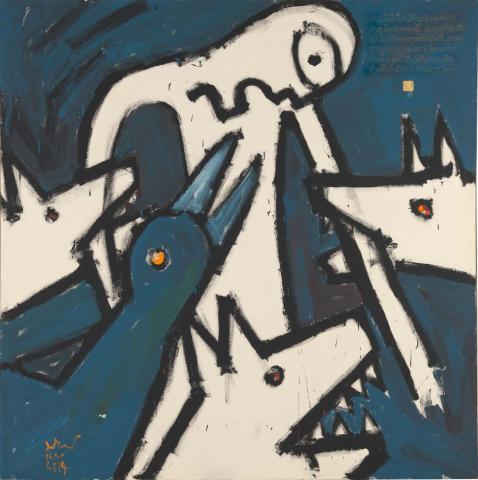SITTHIKET, Vasan; Sinners are gunmen who serve the mafia and tyranny...
Vasan Sitthiket has played a significant role in the development of experimental art practice in Thailand. In the late 1970s he was introduced to German Expressionism and Allan Kaprow's seminal writings from the late 1960s that theorised the conceptual fusing of art and everyday life. Sitthiket was inspired to move away from Thai academic modes of painting and experiment with expressionism, poetry and performance. He was an active participant in the violent student uprisings in Bangkok that ousted the military dictatorship in 1976, and his aesthetic explorations have subsequently been underpinned by a concern about growing political and social injustices, and a desire to find radical methods of addressing them.
In his early works Sitthiket deals with some of the most taboo of Thai social issues: corruption, prostitution, child labour, and poverty. The imagery in his paintings of the 1980s are often disturbing, featuring tortured and alienated individuals set against a background of rapid industrialisation and environmental destruction. These troubling visions of contemporary Thai society were accompanied by poetry readings and performance, which were at times enacted in busy public thoroughfares.
During the 1990s Sitthiket consolidated his reputation for creating radical works that addressed some of Thailand's most difficult social and political issues through two key exhibitions at the National Gallery, Bangkok. His series of nine paintings gifted to the Queensland Art Gallery are from the 1991 'Inferno' exhibition that was staged at the National Gallery, Bangkok, during the turbulent period after the 1991 military coup that overthrew General Chatichai Choonhavana's government. Portraying visions of hell for sinners full of greed, lust and hate, these works engage directly with Thailand's mounting corruption, and anticipate the violence that would accompany the clash between demonstrators and authorities in the 1992 May massacres. Like a premonition reflecting the barbaric events to come, the works are scribed with poems detailing the atrocities which would be perpetrated by soldiers, police officers and ministers. In retribution, the ghost-like bodies of Sitthiket's figures twist and contort, responding to the severe punishments inflicted on them for their sins. Other tortures are prescribed for lawyers who make money from crime, doctors who refuse to treat poor patients, and industrialists who exploit natural resources. Whilst deeply critical of those in power, the ordinary man does not escape Sitthiket's wrathful brush and artists, students, civil servants and disc jockeys are equally called to account for their apathy.
The Inferno series is inspired by Sitthiket's readings of Traibhum-Phra Ruang: The book of three worlds, an important Thai Buddhist manuscript which describes the different states of suffering and hell dealt to those who behave immorally. This text vividly articulates the potential for a darker side to human nature. While many Thai artists, architects and writers have been influenced by the structure and disturbing visions contained within this text, it is an aspect of Buddhism that is little understood. Viewing his role as an artist as one with a responsibility to make people aware of the society they live in, Sitthiket draws attention to the confluence between these more disquieting visions in the Buddhist imaginary and the stark realities of life in the 'land of smiles'.
In an interview undertaken when the paintings were first exhibited, Sitthiket said: 'You should read for yourself to see how imaginative the scare tactics of our forefathers were. Probably you should also read the ancient laws, "Kot Mai Tra Sam Duang", to see the extent of the tortures actually used to keep social order. When we look back at our culture, we tend to see only its beauty and greatness. We tend to overlook the ugly, violent side which is just as real.'(1)
The Inferno paintings are intended to shock. The works feature vibrant colours, dramatic compositions and expressive brushstrokes; the brutal strength of the skeletal figures carry a haunting beauty that explores the depths of the human spirit. The 'Inferno' series broke new ground in the local Thai art scene, opening up a critical dialogue with experimental art on a broader level. This significant body of work established Sitthiket as one of the most controversial and important artists of his generation.
1. Ekachai, Sanitsuda. 'Vasan's view of life: Hell wherever you turn.' Bangkok Post, vol.46, no. 180, 29 June 1991, p.21.
